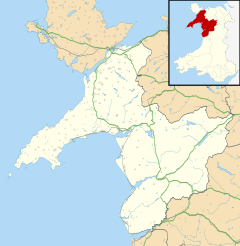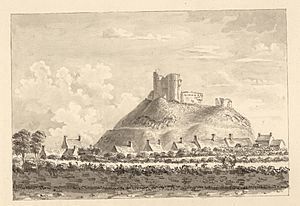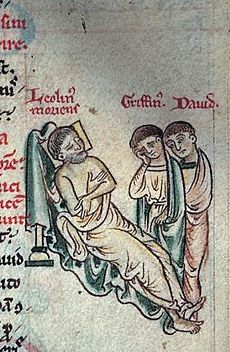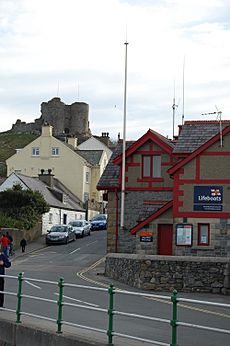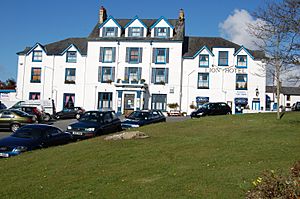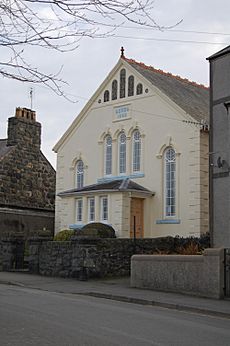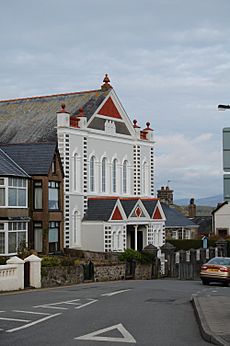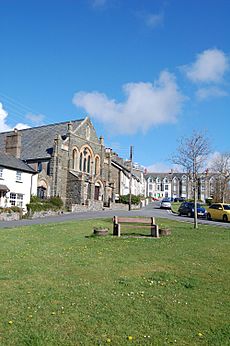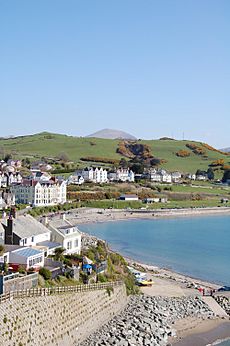Criccieth facts for kids
Quick facts for kids Criccieth
|
|
|---|---|
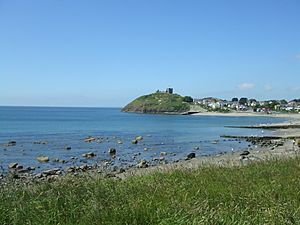 The ruins of Criccieth Castle dominate the town |
|
| Population | 1,753 (2011) |
| OS grid reference | SH505385 |
| Community |
|
| Principal area | |
| Ceremonial county | |
| Country | Wales |
| Sovereign state | United Kingdom |
| Post town | CRICCIETH |
| Postcode district | LL52 |
| Dialling code | 01766 |
| Police | North Wales |
| Fire | North Wales |
| Ambulance | Welsh |
| EU Parliament | Wales |
| UK Parliament |
|
| Welsh Assembly |
|
Criccieth, also known as Cricieth ([ˈkrɪkjɛθ]), is a lovely town in Gwynedd, Wales. It sits right on the coast, where the Llŷn Peninsula meets Eifionydd. The town is about 5 miles (8 km) west of Porthmadog and 9 miles (14 km) east of Pwllheli. In 2011, about 1,753 people lived here.
Criccieth is a popular seaside resort, especially for families. One of its main attractions is the old Criccieth Castle, which offers amazing views of the town and the countryside. Close by, you can find Cadwalader's Ice Cream Parlour, which first opened in 1927. The High Street also has many nice restaurants. In the town center is Y Maes, an old common area from medieval times.
The town is famous for its fairs held every year on May 23 and June 29. Many people come to enjoy the funfair and market that spreads through the streets. Criccieth also hosted the National Eisteddfod in 1975, which is a big Welsh festival of music and poetry. In 2003, it became a Fairtrade Town. It even won the "Wales in Bloom" competition for several years in a row!
Criccieth calls itself the "Pearl of Wales on the Shores of Snowdonia," and it's easy to see why!
Contents
- What's in a Name? The Meaning of Criccieth
- A Look Back in Time: Criccieth's History
- How Criccieth is Governed
- Criccieth's Surroundings: Geography
- Who Lives in Criccieth? Demographics
- How People Make a Living: Economy
- Important Places: Landmarks
- Famous People from Criccieth
- Helping at Sea: Lifeboat Station
- Getting Around: Transport
- Learning in Criccieth: Education
- Town Life: Culture
- Places of Worship: Religion
- Fun and Games: Sport
- See also
What's in a Name? The Meaning of Criccieth
The name Criccieth has a long history. The oldest way it was written in Welsh was "Kastell Krukeith," which means 'castle of Cruceith'.
There are a few ideas about what "Criccieth" means. The most popular idea is that it comes from "crug caeth." The word caeth can mean 'prisoner'. So, the name could mean 'prisoner's rock', possibly because one of Llywelyn ab Iorwerth's sons was held in the castle by his brother. Another idea is that caeth meant 'serfs' (people who worked the land), so it could refer to a community of serfs nearby.
Later, the town was also called Treferthyr, meaning 'martyr's town'. This might be because the local church is named after Saint Catherine.
Today, the official Welsh spelling is Cricieth. However, the post office, maps, and the town's legal name still use Criccieth. The town council has decided to keep the Criccieth spelling for both Welsh and English.
A Look Back in Time: Criccieth's History
Early Settlements and the Castle
The area around Criccieth has been lived in since the Bronze Age. You can still see an old burial site called Cae Dyni near the coast. It has seven upright stones and some interesting cup marks. Around 400 BC, Celtic people likely settled here after exploring the Irish Sea.
Criccieth Castle was probably built around 1230 by Llywelyn ab Iorwerth, a powerful Welsh prince. The first time the castle was mentioned in records was in 1239.
After Llywelyn died in 1240, his son Dafydd took over. Dafydd held his half-brother Gruffydd prisoner in Criccieth Castle. Later, Gruffydd was moved to the Tower of London.
Edward I and the English Rule
When Edward I became king of England in 1272, he wanted to control Wales. After a war, Llywelyn's nephew, Llywelyn ap Gruffudd, had to accept Edward as his ruler. But in 1282, a rebellion started across Wales, and Llywelyn was killed.
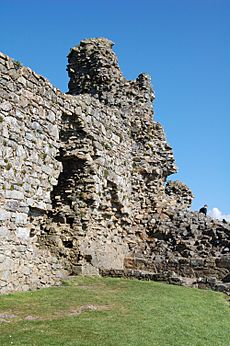
After Wales was defeated, Edward I made Criccieth Castle stronger. It became one of many castles that helped Edward control his new lands. In 1284, the town was given a special charter. This meant English people were encouraged to live there and provide food for the soldiers. Markets were held every week, and there were annual fairs.
However, the Welsh people were not happy with the new English rule. In 1294, Madog ap Llywelyn led a big Welsh rebellion. Criccieth Castle was surrounded for several months. People from the town and soldiers hid inside until supplies arrived. The castle was also used to hold prisoners from Edward's wars against Scotland.
Changes Over Time
Over time, Welsh people started to gain more power in the town. In 1359, Hywel ap Gruffydd became the first Welshman to be in charge of the castle. He was also mayor of the town for 20 years.
In 1400, a new Welsh revolt began, led by Owain Glyndŵr. Owain was declared Prince of Wales, and many towns joined his cause. In 1404, Criccieth Castle was attacked and burned. Its walls were torn down, and the castle was never used again. The town became a small Welsh village, no longer important in big political matters.
The town started to grow again in the 1800s. A new road was built in 1807. Then, in 1868, the railway arrived, and Criccieth began to become a popular Victorian seaside resort.
David Lloyd George and the Storm
A famous person from Criccieth was David Lloyd George. He was a lawyer from the town who became a Member of Parliament in 1890. He held this position for 55 years! From 1916 to 1922, he was the Prime Minister of the UK. He helped lead Britain to victory in the First World War. He also started important social programs like old age pensions and unemployment payments. Because of him, Criccieth became known around the world.
In October 1927, a huge storm hit Criccieth. High waves and strong winds destroyed houses near the sea. These houses had to be pulled down, and the people living there found new homes.
How Criccieth is Governed
Criccieth has two main levels of local government. The first is the Criccieth Town Council, which handles local matters for the town. They meet at the Memorial Hall on High Street. The second is Gwynedd Council, which is responsible for the wider county area.
Criccieth is part of the Dwyfor Meirionnydd area for elections to the UK Parliament and the Welsh Parliament (Senedd).
Past Government
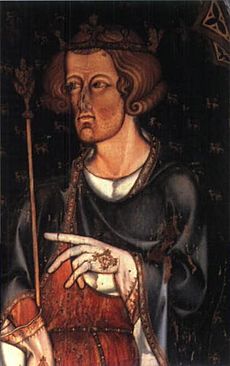
Criccieth was an old parish and an important town in the area called Eifionydd. In 1284, Edward I made Criccieth a borough and gave it a special charter. This meant it had certain rights and its own mayor.
For a long time, the person in charge of the castle was also the mayor. The old Town Hall was even inside the castle grounds! Over the years, the town's local government changed. In 1873, a new local board was created to manage the town better, and the old borough government ended. In 1894, this board became an urban district. Finally, in 1974, the urban district was replaced by the current Criccieth community, and local services are now handled by Gwynedd Council.
Criccieth's Surroundings: Geography

Criccieth is located on the Cardigan Bay coast of the Llŷn Peninsula. The town faces south and is built around the rocky hill where Criccieth Castle stands. This hill divides the coastline into two parts. The East Shore has a sandy beach, perfect for swimming. The Marine Beach, to the west, is quieter and has hotels.
The castle is built on very strong rock. However, the cliffs on either side are made of softer material left behind from the last ice age. Sea walls have been built over the years to protect the town from the sea.
Criccieth has a mild, wet climate because of the Gulf Stream. It rarely snows or freezes. This climate makes the countryside very green and allows many delicate plants to grow wild, like gorse, which flowers all year. A special plant called the Oxenbould daisy, which is unusual for Criccieth, was brought here in the late 1800s.
| Climate data for Criccieth | |||||||||||||
|---|---|---|---|---|---|---|---|---|---|---|---|---|---|
| Month | Jan | Feb | Mar | Apr | May | Jun | Jul | Aug | Sep | Oct | Nov | Dec | Year |
| Mean daily maximum °C (°F) | 8.0 (46.4) |
8.0 (46.4) |
9.0 (48.2) |
11.0 (51.8) |
14.0 (57.2) |
17.0 (62.6) |
18.0 (64.4) |
19.0 (66.2) |
17.0 (62.6) |
14.0 (57.2) |
11.0 (51.8) |
9.0 (48.2) |
12.9 (55.3) |
| Mean daily minimum °C (°F) | 3.0 (37.4) |
3.0 (37.4) |
4.0 (39.2) |
5.0 (41.0) |
8.0 (46.4) |
10.0 (50.0) |
12.0 (53.6) |
12.0 (53.6) |
11.0 (51.8) |
9.0 (48.2) |
6.0 (42.8) |
4.0 (39.2) |
7.3 (45.1) |
| Average precipitation mm (inches) | 83.8 (3.30) |
55.9 (2.20) |
66.0 (2.60) |
53.3 (2.10) |
48.3 (1.90) |
53.3 (2.10) |
53.3 (2.10) |
73.7 (2.90) |
73.7 (2.90) |
91.4 (3.60) |
99.1 (3.90) |
94.0 (3.70) |
845.8 (33.3) |
Who Lives in Criccieth? Demographics
In 2001, Criccieth had 1,826 people. Most of them (62.76%) were born in Wales, and about a third (32.61%) were born in England. Most homes (62.54%) were owned by the people living in them.
| Population change in Criccieth | ||||||||||
|---|---|---|---|---|---|---|---|---|---|---|
| Year | 1801 | 1811 | 1821 | 1831 | 1841 | 1851 | 1861 | 1871 | 1881 | |
| Population | 396 | 459 | 530 | 648 | 811 | 797 | 498 | 901 | 1,213 | |
| Year | 1891 | 1901 | 1911 | 1921 | 1931 | 1939 | 1951 | 1961 | 2001 | 2011 |
| Population | 1,507 | 1,406 | 1,376 | 1,886 | 1,449 | 2,290 | 1,652 | 1,672 | 1,826 | 1,753 |
| Sources: | ||||||||||
How People Make a Living: Economy
In the 1500s, Criccieth had a mill powered by water. By the 1800s, the herring fishing industry was important. People would bring their fish to Abermarchnad to be taken to other villages. There was also a place to store coal and a lime kiln for making lime.
In 2001, about 54% of the people in Criccieth had jobs. Most worked in shops, hotels, and restaurants.
Important Places: Landmarks
Criccieth Castle is the most famous landmark, sitting on a rock overlooking Cardigan Bay. Not much of the original castle remains, but its outer walls are still impressive. The inner part has the oldest remains, including the gatehouse with two round towers.
Caffi Cwrt, built in the early 1700s, was where town officials held meetings if it rained. Ty'r Felin is a 17th-century cottage, and Foinavon was once owned by the family who made Bird's Custard.
Morfin, on Tan-y-Grisiau Terrace, was used as an office by David Lloyd George when he was a lawyer. Ty Newydd, from the mid-1500s, was originally built for the estate manager. The first council houses in Criccieth were built on land given to help families who lost their homes in the 1927 storm. Wellington Terrace has three 600-year-old cottages, thought to be the oldest in town.
Castle Road is part of the original settlement, Yr Hen Dref. Ty Mawr, a 16th-century building, was once a small farm and then a pub. The Castle Bakery next door has a stained glass window showing bakers at work. In the past, people could bring their own dough to be baked there. Near the castle entrance, Gardd y Stocs was where the town's stocks (a device used for punishment) were kept. The building that is now the castle information center was once part of the town's guildhall.
The center of the old town is Y Dref. This was where the weekly market was held and where many political meetings took place.
On the green at West Parade, there's a shelter given by Margaret Lloyd George, the wife of the former prime minister.
Muriau, on Lôn Fel, includes old farm buildings from the 1600s that were turned into houses. Bryn Awelon was the home of David Lloyd George before the First World War, and later his daughter Megan lived there.
Ger y Maes, a house on Holywell Terrace, is near an old well called Ffynnon y Saint, which supplied much of the town's water.
The former National Westminster Bank on the High Street has a unique design. On the south side of the street, there are many 19th-century shops, like the Medical Hall (from 1875) and Siop Newydd (built in 1869).
At the east end of the Esplanade is the Morannedd Café, built in 1954.
Talhenbont Hall is a historic manor house from 1607. It was once owned by important families and was even taken over by Cromwell's men in 1642. Today, it's a holiday center.
Famous People from Criccieth
- Sir Llewelyn Turner (1823–1903), a politician and Mayor of Caernarfon.
- David Lloyd George (1863–1945), who grew up nearby and became the UK Prime Minister.
- Margaret Lloyd George (1864–1941), a Welsh humanitarian and wife of David Lloyd George.
- Robert Jones (1891–1962), a mathematician and expert on airships.
- Group Captain Leslie Bonnet (1902–1985), an RAF officer and writer.
- Megan Lloyd George (1902–1966), a politician and the first female Member of Parliament in Wales, daughter of David Lloyd George.
- William George (1912–2006), a poet and nephew of David Lloyd George.
- Joan Hutt (1913–1985), an artist and wife of Leslie Bonnet.
- Ruth Martin-Jones (born 1947), a former long jumper and heptathlete.
- Paul Roberts (born 1977), a Welsh former footballer.
- Dyfan Dwyfor, an actor who won an award at the National Eisteddfod in 2004.
Helping at Sea: Lifeboat Station
The Royal National Lifeboat Institution (RNLI) has a lifeboat station in Criccieth. It was built in 1853. It closed for a while but reopened in 1953. It uses an Atlantic 85 lifeboat and a smaller Arancia lifeboat, which can go into shallower waters.
Getting Around: Transport
Criccieth is on the A497, the main road that goes through the southern Llŷn Peninsula. The B4411 road goes north from Criccieth towards Caernarfon.

The town has a train station called Criccieth railway station. It's on the Cambrian Coast Line, with trains going to places like Shrewsbury and Birmingham. The local community takes care of the station, adding flowers and artwork.
Buses are also available, connecting Criccieth to nearby towns like Pwllheli, Porthmadog, and even further places like Bangor and Aberystwyth.
Learning in Criccieth: Education
Children in Criccieth attend Ysgol Treferthyr for primary school. In 2010, most students spoke Welsh at home, and Welsh is the main language used for teaching. For secondary school, most students go to Ysgol Eifionydd in Porthmadog.
Town Life: Culture
Criccieth is a strong Welsh-speaking community. In 2011, about 64% of residents aged three and over could speak Welsh.
The Memorial Hall is a place for concerts, plays, and other community events, especially during the annual Criccieth Festival. It was finished in 1925.
Criccieth Library on the High Street was built with money from Andrew Carnegie. It offers free internet access.
The National Eisteddfod was held in Criccieth in 1975. A new housing area, Gorseddfa, marks where the Gorsedd stones (used in Eisteddfod ceremonies) once stood.
The Brynhir Arms, a pub on the High Street, dates back to 1631. The Lion Hotel, an old coaching inn built in 1731, was where town officials would go after their meetings.
Many of the town's hotels, like the Marine Hotel and the Caerwylan Hotel, were built after 1811. The George IV Hotel, built in 1830, was once known for having its own electricity!
Clwb Cerdd Dwyfor hosts music performances, from folk to opera. Côr Eifionydd, a mixed choir, has won awards at the National Eisteddfod and toured internationally.
There's an old custom on Easter Sunday where people would throw keys or pins into Ffynnon Fair as an offering.
Criccieth is even mentioned in a funny poem by Robert Graves and appears in a painting by Joseph Mallord William Turner. There's also a local legend about three musicians who were lured into a cave by fairies and were never seen again, though their music can sometimes still be heard.
Places of Worship: Religion
Religion has always been important in Criccieth. Around 1300, St Catherine's Parish Church was built. It was made bigger in 1500 and restored in 1869. It has old wooden panels and a communion table from the 1600s. In the graveyard, the oldest stone is from 1688. Outside, there's a sundial from 1734.
In 1749, Griffith Jones's Circulating School visited St Catherine's. Out of 600 people, 543 who couldn't read were taught so they could understand the Bible.
By the 1800s, many people in Wales were nonconformists (Protestants who were not part of the Church of England). Criccieth also saw many new chapels built. Jerusalem Congregational Chapel was built in 1886.
Capel Uchaf, built in 1791, was for the Scottish Baptists. David Lloyd George's uncle often preached here, and Lloyd George himself was baptized in the river nearby. In 1886, the Baptists moved to a new church called Berea.
The Calvinistic Methodists built Capel Mawr in 1813. Later, a second chapel, Capel y Traeth, was built in 1895. It was known as Capel Seion but was renamed in 1995 when its congregation joined with Capel Mawr.
Salem Methodist Chapel was built in 1901 and is now a chapel of rest.
Roman Catholics worship at the Church of the Holy Spirit. Criccieth Family Church meets at the Holiday Club Hall.
For over 100 years, people have gathered on Sunday evenings at Abermarchnad for community hymn singing.
In 2001, about 82% of the people in Criccieth said they were Christian, while about 12% said they had no religion.
Fun and Games: Sport
Criccieth Tennis Club is one of the oldest clubs around, started in 1882. Many famous players have played here.
Golf started in Criccieth with a few holes on Caerdyni Hill. In 1906, Criccieth Golf Club opened. It was a nine-hole course with great views. Three British prime ministers, Bonar Law, David Lloyd George, and Winston Churchill, once played the course on the same day! The club closed at the end of 2017.
The town is a great place for sea fishing. You can catch bass, dogfish, mackerel, and whiting from the East Shore. The Stone Jetty is good for conger eels, pollock, and wrasse.
Criccieth, Llanystumdwy and District Angling Association manages fishing rights on the Afon Dwyfor and Afon Dwyfach rivers. They catch many sea trout and salmon each year and even run a hatchery to raise sea trout. Gloddfa Lake, an old quarry pool, is a good spot for rudd, roach, and eels.
Swimming is popular, especially on the East Shore, which is sandy and safe for children. At low tide, you can explore rock pools. The Marine Beach, west of the castle, is pebbly. Both beaches have good water quality and have won seaside awards.
Surfing is possible here, but it's not always consistent. The best waves come from the southwest.
You can also play crown green bowls at Criccieth Bowling Club, and there's a miniature golf course nearby.
|
See also
 In Spanish: Criccieth para niños
In Spanish: Criccieth para niños


